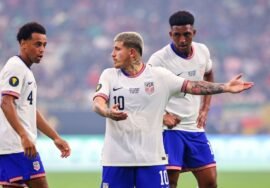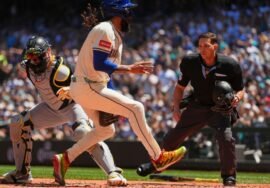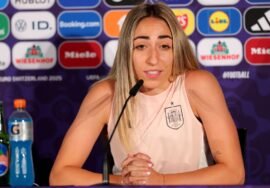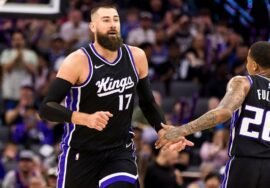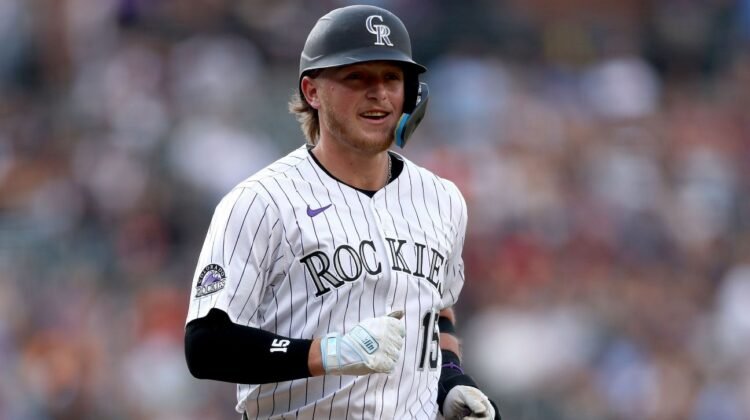
The most obscure MLB All-Stars you’ve probably never heard of
The Colorado Rockies, on pace for the modern record for losses in a season set last year by the Chicago White Sox, will have an All-Star in catcher Hunter Goodman. Those are the rules, of course — every team gets an All-Star representative. Is Goodman one of the best 32 players in the National League? Probably not, but he’s having a nice season and is maybe the second-best catcher of the first half in the NL. And now he’ll forever get to call himself an All-Star.
According to data at Baseball-Reference.com, there have been 2,227 All-Stars in MLB history, including those selected to the Negro Leagues East-West All-Star Game. That’s out of the 23,521 players who had appeared in the major leagues as of a few days ago. That means nearly 10% of all MLB players have been an All-Star.
You might not have heard of many of them.
Let’s dig into All-Star history and look at some of the most obscure and surprising All-Star selections.
Frankie Zak: The king of obscure All-Stars
One All-Star stands out among all others as the unlikeliest All-Star of all time. It’s a story hard to believe, and it’s all true. It happened during World War II, when the majors were full of minor leaguers and 4-F players unable to serve in the military. It provides context to Zak, who would play just 123 games in the majors, hit no home runs and drive in just 14 runs.
Zak was a 22-year-old rookie backup shortstop for the 1944 Pittsburgh Pirates, a team that featured guys named Babe and Rip and Fritz and Preacher, which tells you this was long ago. Zak made the roster out of spring training but didn’t even start a game until June 1, filling in for a slumping Frank Gustine. Zak got two hits that day, two more the next and two more the day after, and he remained the starting shortstop until the All-Star break, when he was hitting .305 with five RBIs in a grand total of 82 at-bats.
The All-Star Game happened to be in Pittsburgh that year. The backup shortstop was Eddie Miller of the Cincinnati Reds — a seven-time All-Star — but Miller was injured and unable to attend the game. With wartime travel restrictions in place, manager Billy Southworth sought a local replacement, but Pirates infielder Pete Coscarart had gone fishing and third baseman Bob Elliott was already on the team. Zak was in town and put on the roster. As ESPN’s Steve Wulf once wrote: the accidental All-Star.
Alas, starter Marty Marion played the entire game, with Zak not appearing in the contest. He finished the season hitting .300 in 160 at-bats, played sparingly for the Pirates the next two seasons and died of a heart attack at age 49 in 1972.
The most obscure All-Star starter
Through the years, I have spent untold hours looking at All-Star Game box scores, perusing rosters and wondering how some guys got selected. Somehow, I had skipped right past Eddie Kazak — until last week, when his name popped up. My knowledge of baseball history is, shall we say, reasonably deep, but I had never heard of him. And Kazak had not only been an All-Star but started the 1949 contest.
A 28-year-old rookie third baseman for the St. Louis Cardinals, Kazak had served in Europe during World War II, spending 18 months in the hospital after his right elbow had been crushed by shrapnel and falling mortar during an artillery attack in France in July 1944. Doctors considered amputating the arm before using pieces of plastic to repair his shattered elbow.
“I was warned to give up baseball because throwing might dislocate the synthetic elbow,” Kazak had told the AP.
Kazak reached the majors briefly in 1948, and with regular third baseman Whitey Kurowski unable to throw because of bone chips in his elbow in 1949, Kazak got the opportunity to play. His first home run was a grand slam. At the All-Star break, he was hitting .302 with four home runs and 38 RBIs. The Chicago Tribune ran the fan balloting to elect the starters that year and the fans, no doubt appreciating Kazak’s war hero background, voted him as the starter over the more accomplished Elliott (the 1947 NL MVP) and Sid Gordon (.310 with 16 home runs at the break).
Kazak went 2-for-2 in the game, but two weeks into the second half, suffered bone chips in his right ankle sliding into second base and played sparingly the rest of the season. He was never again a regular, and his major league career was over by 1952 with just 218 career games, although he played in the minors until 1960.
The Eddie Kazak All-Star lineup
In honor of Kazak, let’s pick a team of unlikely players who started an All-Star Game at each position, although we’ll skip over anyone from the World War II years, when the competition was significantly diluted. These guys all had significant careers but wouldn’t be the type of players you associate with the title of “All-Star starter.”
C: John Romano (1961)
Romano started both games in 1961 (there were two games each year from 1959 to 1962 to help fund the players’ pension fund), a season in which he hit .299/.377/.483 with 21 home runs and 80 RBIs for Cleveland. He was a legit All-Star that year and again in 1962, posting similar power numbers, but he had trouble keeping his weight down and was out of the league by 1967.
1B: Justin Smoak (2017)
A first-round pick by the Texas Rangers in 2008, the Rangers sent him to the Seattle Mariners for Cliff Lee during his rookie season in 2010. The Mariners waited and waited for Smoak to break out; I don’t think a first baseman was ever given so many plate appearances with such mediocre results. They finally waived him, and the Blue Jays signed him. Then, in 2017, he put together an All-Star-worthy first half, hitting .294 with 23 home runs. Smoak would finish his career with 6.8 WAR in nearly 5,000 plate appearances — 3.1 of that coming in 2017.
2B: Mariano Duncan (1994)
Duncan had a 12-year MLB career, but most of that was spent as a utility player, and he had just three seasons with 500 plate appearances. In 1994, Duncan did start regularly at three infield positions for the Phillies, who were coming off a World Series appearance in 1993, and Phillies fans stuffed the ballot box to elect him despite mediocre numbers. Duncan was hitting .265 with a .712 OPS at the break, getting the starting nod over future Hall of Famer Craig Biggio, who was hitting .320 with an .894 OPS.
3B: Eddie Kazak (1949)
Obviously, Kazak gets the nod here. But an honorable mention goes to Ken Reitz, who started the 1980 All-Star Game for the NL over the injured Mike Schmidt. Reitz had over 5,000 career plate appearances, but finished with minus-3.2 career WAR, making him one of 11 All-Star position players who finished their careers with negative WAR.
SS: Orlando Arcia (2023)
This happened just two years ago, and while Arcia has been around since 2016, he’s the least accomplished shortstop to ever start an All-Star Game, with just 4.2 career WAR and a career OPS+ of 77. He did hit well in the first half of 2023 for the Atlanta Braves, although check out these first-half stats from that year:
Arcia: .294/.345/.424, 7 HR, 28 RBI
Francisco Lindor: .239/.320/.478, 19 HR, 60 RBI
Lindor didn’t even make the team.
LF: Iván Calderón (1991)
We could go with a couple of recent NL starters here — Jurickson Profar last year or Jesse Winker in 2021 — but Calderon is a fun blast from the past. A talented prospect for the Mariners, Seattle traded him after manager Dick Williams caught him eating a sandwich during a game. He made his only All-Star appearance with the Montreal Expos, hitting .309 with nine home runs and 49 RBIs at the break (solid numbers for that era), and drew the start with Darryl Strawberry injured.
CF: Kosuke Fukudome (2008)
You might remember the name, but you probably don’t remember that Fukudome started as a rookie in 2008. A 31-year-old veteran from Japan when he signed with the Chicago Cubs, Fukudome had a lot of hype entering the season and was OK but hardly great in the first half — .279/.383/.408, seven home runs. He got elected to start, and while he was primarily a right fielder, he drew the assignment in center field over the even less defensively-inclined Ryan Braun and Matt Holliday. Fukudome slumped in the second half and ended the season with just 0.6 WAR.
RF: Pat Mullin (1948)
If we went strictly by lowest career WAR, the answer here would be Don Mueller (1955) or Dante Bichette (1996), both of whom finished with fewer than 5 career WAR (Bichette, thanks to his Coors Field-inflated numbers, made four All-Star teams). Mullin was a two-time All-Star in 1947 and ’48, the only two seasons he was a regular in the majors. He was a solid platoon hitter who finished with 10.4 career WAR, missing four prime seasons while serving in the war.
DH: Corey Dickerson (2017)
Dickerson was your classic journeyman-type outfielder who played 11 seasons in the majors. Alongside his teammate Smoak with the Blue Jays, he had a big first half in 2017, hitting .312 with 17 home runs.
SP: Dave Stenhouse (1962)
A rookie for the woeful Washington Senators, Stenhouse was 10-4 with a 2.73 ERA when he started the second All-Star Game that season on July 30 (there were two All-Star Games held in each season from 1959 to 1962, in order to increase the money going to the players’ pension fund). I had always wondered why Stenhouse drew the start since he finished the season 11-12 with a 3.65 ERA, but he had good stats at the time. It’s also clear that this stretch probably ruined his career. Heading into the All-Star Game, he had starts of 10 innings, seven, nine, nine and nine, with one relief outing thrown in as well. On July 27, he faced 43 batters, throwing an estimated 160 pitches. Then he pitched two innings in the All-Star Game. Two days later, he threw 10 innings again.
He was never the same. He had a 5.54 ERA over the final two months, then battled injuries the next two seasons, finishing his career with a 16-28 record.
The anonymous All-Star lineup
The players above might have been surprising starters, but at least they had solid and long careers. It does make you wonder about what the percentage is of players who have a 10-year career and also make an All-Star team. There’s a good chance that if you’re good enough to last that long, you were good enough at some point to have a half-season somewhere along the way that makes you an All-Star.
Here’s a different type of lineup — and yes, these guys were, in fact, all All-Stars. Let’s call them, umm, a more anonymous list of All-Stars.
C: Steve Swisher (1976)
The father of 2010 All-Star Nick Swisher, Steve was a Cubs catcher who would have a .216 career batting average in under 1,600 plate appearances and finish with minus-1.9 career WAR. He hit .268 with three home runs in the first half of 1976 — and for some reason was selected as the Cubs’ representative over Bill Madlock (who won the batting title that year and was eighth in the NL in OPS at the All-Star break) or Rick Monday (who had 15 home runs and was ninth in OPS).
1B: Bryan LaHair (2012)
This is one of the best All-Star stories ever. LaHair was a 29-year-old minor league journeyman who got a chance to play for the Cubs in 2012 during their rebuilding phase. He hit .390 in April, and the players voted him as the backup at first base. He tailed off from there, didn’t play much in the second half and signed to play in Japan in 2013, never playing again in the majors. With 599 career plate appearances in the majors, he has the fourth-fewest plate appearances of any position player All-Star (behind our man Frankie Zak, last year’s All-Star David Fry and a catcher named Don Leppert).
2B: Mike Sharperson (1992)
Yes, there was a time when the Los Angeles Dodgers were bad and irrelevant. That year was 1992: They lost 99 games, and their All-Star rep was a 30-year-old backup infielder. Sharperson had started only 48 games in the first half but was hitting .328 with a .424 OBP. He fell off in the second half and by 1994 was back in the minors (before tragically dying in a car crash in 1996).
3B: Don Wert (1968)
OK, 1968 was the Year of the Pitcher, and Wert’s Detroit Tigers would go on to win the World Series, but Wert was hitting .220 with seven home runs and 19 RBIs at the All-Star break — weak numbers even by 1968 standards. However, he somehow got the backup nod behind Brooks Robinson over Sal Bando or Ken McMullen. Wert finished his All-Star season hitting .200 with a .258 OBP and 37 RBIs, making his selection look even more dubious.
SS: Billy Hunter (1953)
The worst hitter to ever make an All-Star team? By career OPS+, it’s Hunter, who was worse even than Swisher with a career OPS+ of 53 in just over 2,000 career plate appearances. He made the All-Star team as a rookie with the St. Louis Browns in 1953 — and wasn’t even their only rep, as Satchel Paige also made it. How did Hunter make it when he finished the year hitting .219/.253/.259 with one home run for an OPS+ of 37? He was a defensive whiz (he would lead the AL in defensive WAR that year) but he was also hitting .307 in early June. He didn’t bat in the game but did pinch run for Mickey Mantle.
OF: Myril Hoag (1939)
By career WAR, Hoag is the worst player ever to make an All-Star team. Primarily a backup outfielder in a 13-year career, Hoag finished with minus-4.6 career WAR, with an OPS+ of 83. He made the AL team with the Browns in 1939, hitting .319 in the first half. Here’s the more amazing part of this story though: In 1936, while with the Yankees, Hoag collided with Joe DiMaggio in the outfield. Both players were knocked unconscious, but Hoag played the next day. Two days later, however, he suffered a blood clot on the brain and was rushed into emergency surgery, missing the rest of the season. He returned to become an All-Star three years later.
OF: Domonic Brown (2013)
Brown was a heralded Philadelphia Phillies prospect — Baseball America’s No. 4 overall prospect entering the 2011 season — who was one of the worst defensive outfielders I’ve ever seen. He never hit much either, except for two months in 2013, when he hit .290 with 18 home runs in May and June, earning All-Star honors. Two years later, he was out of the majors.
OF: Richie Scheinblum (1972)
A 29-year-old journeyman with little time in the majors when the Kansas City Royals acquired him in 1972, Scheinblum parlayed his one season as a regular into an All-Star appearance while nearly winning a batting title, leading the AL for much of the season before finishing sixth with a .300 average. He didn’t have much power and was a poor defensive outfielder, however. Kansas City traded him in the offseason (for Royals legend Hal McRae) and he was out of the league within two years.
DH: Daniel Vogelbach (2019)
The 2019 Mariners were not a good team — they lost 94 games — but did have nine other players who made an All-Star team at some point in their career. Their selection, however, was their lovable DH, who was hitting .238 with 21 home runs at the break before slumping to .162 with nine home runs in the second half.
SP: Mark Redman (2006)
There is no shortage of candidates for the pitcher slot, but Redman holds the honor as the starting pitcher who finished his All-Star season with the highest ERA — 5.71. But maybe he had a good first half? Nope. Pitching for the Royals, Redman was 6-4 with a 5.19 ERA, with equal totals of walks and strikeouts (32). The Royals, you won’t be shocked to learn, lost 100 games that year.
RP: Derrick Turnbow (2006)
What was in the air in 2006? Turnbow holds the mark for lowest WAR in an All-Star season at minus-2.4. He had a lights-out year as the Milwaukee Brewers’ closer in 2005, posting a 1.74 ERA with 39 saves, but he didn’t make the All-Star team that season. He made it in 2006, when he would finish 4-9 with a 6.87 ERA and 24 saves. To be fair, he was a little better in the first half with a 4.74 ERA, but it was still a strange selection. Honorable mention goes to Mike Williams of the 2003 Pirates, who made the All-Star team despite a first-half ERA of 6.44 (he did somehow have 25 saves).
The other accidental All-Star
Alfredo Griffin had a long career as a defensive specialist, playing 18 seasons and serving as the primary shortstop on the 1988 World Series champion Dodgers even though he hit just .199 that season. He ran the bases as aggressively as a rabid rhino, one season getting thrown out eight times at home plate and seven times at third base. Despite a lowly career WAR of just 3.0, he also once made an All-Star team.
Here’s the story. In 1984, Griffin’s Blue Jays teammate Damaso Garcia made the All-Star team. Players were allowed to bring one guest at MLB’s expense, and when Garcia’s wife couldn’t make it, he invited his double-play partner. Tigers shortstop Alan Trammell came up with a sore arm on the day of the All-Star Game, however, and since Griffin just happened to be in town, manager Joe Altobelli added Griffin to the roster. He even got into the game, making one play in the field but not batting.
Here’s the kicker: Griffin finished the season hitting .241/.248/.298 (he drew just four walks in 140 games) with minus-1.5 WAR, no doubt putting him at the top of the list for worst All-Star season ever. Only one other position player finished with a lower WAR in his All-Star season and it was a much more accomplished player: Reggie Jackson was an All-Star in 1983, a season he hit .198 with minus-1.8 WAR.

